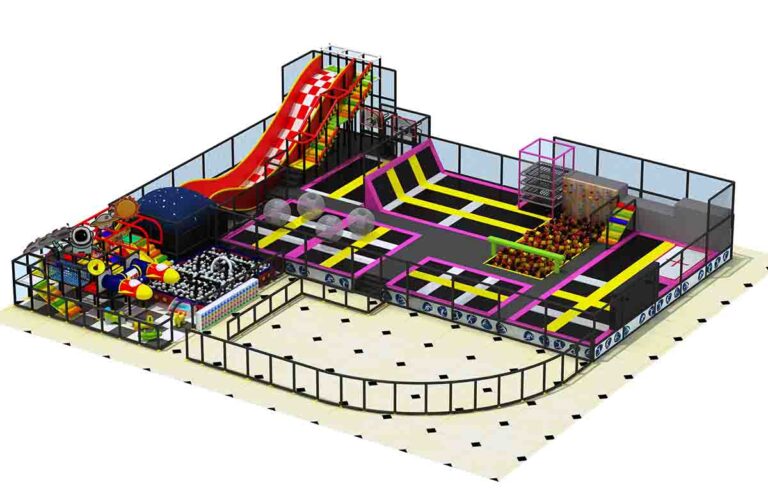The Benefits of Trampolining at Indoor Parks for Physical and Mental Health
Physical Health Benefits
Improved cardiovascular fitness
Improved cardiovascular fitness is one of the key benefits of trampolining at indoor parks. When engaging in this activity, the constant bouncing and jumping motion increases the heart rate, leading to improved cardiovascular health. The repetitive movements help to strengthen the heart muscle, enhance blood circulation, and improve overall endurance. Regular trampolining sessions can also contribute to lowering blood pressure and reducing the risk of heart disease. Additionally, the increased oxygen flow to the brain during trampolining can enhance cognitive function and mental clarity, further promoting overall physical and mental well-being.
Increased muscle strength and tone
Increased muscle strength and tone are significant benefits of trampolining at indoor parks for both physical and mental health. When bouncing on a trampoline, the muscles in the legs, core, and arms are constantly engaged to maintain balance and control. This repetitive movement helps to strengthen and tone these muscle groups over time. The increased muscle strength not only improves overall physical performance but also enhances stability and coordination. Additionally, trampolining provides a low-impact workout, making it suitable for individuals of all fitness levels. Regular trampoline sessions at indoor parks can lead to improved muscle tone, increased endurance, and a more sculpted physique. Moreover, the physical exertion involved in trampolining releases endorphins, which promote a sense of well-being and contribute to improved mental health.
Enhanced coordination and balance
Enhanced coordination and balance are two significant benefits of trampolining at indoor parks for both physical and mental health. When jumping on a trampoline, individuals must constantly adjust their body movements to maintain balance and control. This repetitive action helps to improve coordination as it requires the synchronization of different muscle groups. Additionally, trampolining also enhances balance by challenging the body to maintain stability on an unstable surface. This not only strengthens the core muscles but also improves proprioception, which is the body’s ability to sense its position in space. By regularly engaging in trampolining activities at indoor parks, individuals can experience noticeable improvements in their coordination and balance, leading to better overall physical performance and a heightened sense of body awareness.
Mental Health Benefits
Reduced stress and anxiety
Reduced stress and anxiety are two significant benefits of trampolining at indoor parks for both physical and mental health. Engaging in trampoline activities helps release endorphins, which are known as the “feel-good” hormones, leading to a decrease in stress levels. The repetitive bouncing motion and the feeling of weightlessness can provide a sense of relaxation and relief from daily pressures. Additionally, trampolining promotes the production of serotonin, a neurotransmitter that regulates mood and promotes feelings of well-being. This can help alleviate symptoms of anxiety and improve overall mental health. The combination of physical activity, fun, and the release of these mood-enhancing chemicals makes trampolining an effective way to reduce stress and anxiety.
Improved mood and self-esteem
Engaging in trampolining at indoor parks can significantly contribute to improved mood and self-esteem. The exhilarating experience of bouncing on a trampoline releases endorphins, which are known as the “feel-good” hormones. These endorphins help to alleviate stress, anxiety, and depression, leading to an overall uplifted mood. Additionally, the sense of accomplishment and achievement that comes with mastering new trampoline tricks or overcoming fears can boost self-esteem. The supportive and encouraging environment of indoor parks also plays a crucial role in fostering a positive mindset and enhancing self-confidence. Regular trampolining sessions can therefore have a profound impact on both mental and emotional well-being, leaving individuals feeling happier, more confident, and ready to take on life’s challenges.
Enhanced cognitive function
Enhanced cognitive function is another significant benefit of trampolining at indoor parks. Engaging in this activity requires coordination, focus, and quick decision-making, which can help improve cognitive abilities. The repetitive bouncing motion stimulates the brain and activates various neural pathways, leading to enhanced mental alertness and improved concentration. Additionally, trampolining promotes the release of endorphins, which are known to boost mood and reduce stress levels. This combination of physical activity and mental stimulation can have a positive impact on memory, attention span, and overall cognitive function. Regular trampolining sessions at indoor parks can therefore contribute to a sharper mind and improved mental well-being.
Weight Management
Effective calorie burning
Trampolining at indoor parks is not only a fun and enjoyable activity, but it also offers effective calorie burning benefits. Jumping on a trampoline requires a significant amount of energy, making it a great cardiovascular exercise. In fact, studies have shown that trampolining can burn up to 1000 calories per hour, depending on the intensity of the workout. This makes it an excellent choice for individuals looking to shed some extra pounds or maintain a healthy weight. Additionally, trampolining engages multiple muscle groups, including the legs, core, and arms, which further contributes to calorie burning and overall toning of the body. So, if you’re looking for a fun and efficient way to burn calories, trampolining at indoor parks is definitely worth considering.
Increased metabolism
Increased metabolism is one of the key benefits of trampolining at indoor parks for physical and mental health. When you engage in trampolining, your body is constantly in motion, which helps to increase your metabolic rate. This means that your body is able to burn calories more efficiently, leading to potential weight loss or maintenance. Additionally, the increased metabolism from trampolining can also help to improve digestion and regulate blood sugar levels. As a result, trampolining at indoor parks can be a great way to boost your overall metabolic health and support a healthy lifestyle.
Improved body composition
Improved body composition is one of the many benefits that can be achieved through trampolining at indoor parks. Regular trampoline sessions can help individuals achieve a healthier body composition by reducing body fat and increasing muscle mass. The constant jumping and bouncing on a trampoline engage multiple muscle groups, including the core, legs, and arms, leading to improved strength and toning. Additionally, trampolining is a highly effective cardiovascular exercise that can help burn calories and increase metabolism, contributing to weight loss and a leaner physique. By incorporating trampolining into their fitness routine, individuals can enjoy improved body composition and overall physical well-being.
Joint and Bone Health
Low-impact exercise
Low-impact exercise is one of the key advantages of trampolining at indoor parks for both physical and mental health. Unlike high-impact activities such as running or weightlifting, trampolining provides a gentler form of exercise that puts less strain on the joints and muscles. This makes it an ideal option for individuals with joint issues, arthritis, or those recovering from injuries. The soft surface of the trampoline absorbs the impact of each jump, reducing the risk of injury while still providing an effective cardiovascular workout. Additionally, the low-impact nature of trampolining allows individuals of all fitness levels and ages to participate, making it a versatile and inclusive form of exercise. Not only does this promote physical well-being, but it also contributes to mental health by reducing stress and improving overall mood. The feeling of weightlessness and the release of endorphins during trampolining can help alleviate anxiety and depression, providing a fun and enjoyable way to boost both physical and mental well-being.
Strengthening of bones and joints
Strengthening of bones and joints is one of the key advantages of trampolining at indoor parks for both physical and mental health. When bouncing on a trampoline, the repetitive impact and weight-bearing nature of the activity help to promote bone density and increase bone strength. This is particularly beneficial for individuals of all ages, as it can help prevent conditions such as osteoporosis and reduce the risk of fractures. Additionally, trampolining also aids in the strengthening of joints. The controlled movements and gentle bouncing motion help to improve joint stability and flexibility, reducing the likelihood of joint-related injuries. Regular trampolining sessions at indoor parks can therefore contribute to overall bone and joint health, enhancing the overall well-being of individuals.
Reduced risk of osteoporosis
Trampolining at indoor parks offers a reduced risk of osteoporosis, a condition characterized by weak and brittle bones. Regular trampoline exercise helps to strengthen the bones and increase bone density, which is crucial in preventing osteoporosis. The repetitive jumping motion stimulates the production of osteoblasts, cells responsible for bone formation, leading to stronger and healthier bones. Additionally, trampolining is a weight-bearing exercise that puts stress on the bones, promoting the deposition of calcium and other minerals, further enhancing bone strength. By incorporating trampolining into one’s fitness routine, individuals can significantly reduce their risk of developing osteoporosis and maintain optimal bone health.
Social Interaction and Engagement
Opportunities for group activities
Opportunities for group activities at indoor trampoline parks provide a unique and exciting way for individuals to engage in physical and mental health activities together. These parks offer a range of group-oriented games and challenges that encourage teamwork, communication, and social interaction. Whether it’s a friendly game of dodgeball, a thrilling obstacle course, or a high-flying basketball dunk contest, trampoline parks offer an inclusive environment where people of all ages and fitness levels can come together and have fun. Engaging in group activities at these parks not only promotes physical fitness but also fosters a sense of camaraderie and community among participants. It allows individuals to bond, support each other, and celebrate achievements, creating a positive and motivating atmosphere. Moreover, the shared experience of engaging in group activities at indoor trampoline parks can have a positive impact on mental health by reducing stress, boosting mood, and enhancing overall well-being.
Building friendships and connections
Building friendships and connections is one of the key advantages of trampolining at indoor parks for both physical and mental health. Engaging in this activity provides an opportunity to meet new people who share similar interests and passions. Whether it’s joining a trampoline fitness class or simply bouncing around in the open jump area, trampolining creates a social environment where individuals can interact and bond with others. These shared experiences and connections can lead to the formation of lasting friendships and a sense of belonging. Additionally, trampolining at indoor parks often involves group activities and games, further enhancing the opportunity for social interaction and fostering a sense of camaraderie among participants. The social aspect of trampolining not only adds to the enjoyment of the activity but also contributes to overall well-being by promoting social connections and a sense of community.
Promoting a sense of belonging
Promoting a sense of belonging is a key aspect of trampolining at indoor parks. These parks provide a welcoming and inclusive environment where individuals of all ages and backgrounds can come together and engage in a shared activity. By participating in trampolining sessions, people have the opportunity to connect with others who share similar interests and passions. This sense of belonging fosters a supportive community where individuals can feel accepted and valued. Moreover, the social interactions and friendships formed in these settings contribute to improved mental well-being and overall happiness. Trampolining at indoor parks not only offers physical health benefits but also plays a significant role in promoting a sense of belonging and social connectedness.
Fun and Enjoyment
Release of endorphins
Release of endorphins is one of the key benefits of trampolining at indoor parks for physical and mental health. When we engage in trampolining, our bodies experience a surge of endorphins, which are natural chemicals produced by the brain. These endorphins act as natural painkillers and mood enhancers, promoting feelings of happiness and well-being. The repetitive bouncing and jumping movements on the trampoline stimulate the release of endorphins, leading to a sense of euphoria and reducing stress levels. This release of endorphins not only provides an immediate mood boost but also helps in alleviating symptoms of anxiety and depression. Regular trampolining sessions at indoor parks can therefore contribute to improving both our physical and mental well-being.
Boosting of mood and happiness
Boosting of mood and happiness
Trampolining at indoor parks not only provides a fun and exhilarating experience but also has the potential to significantly boost mood and happiness. The act of bouncing on a trampoline releases endorphins, which are known as the “feel-good” hormones. These endorphins help to reduce stress levels and promote a sense of well-being. Additionally, trampolining is a physical activity that increases blood flow and oxygen circulation throughout the body, leading to a natural mood enhancement. The combination of the physical exertion and the joyous nature of bouncing on a trampoline can instantly uplift one’s spirits and leave them feeling happier and more content. Moreover, trampolining at indoor parks often involves social interaction and group activities, which further contribute to a positive mood and a sense of belonging. Overall, engaging in trampolining at indoor parks can have a profound impact on both physical and mental health, leaving individuals feeling happier, more energized, and ready to take on the world.
Engaging in a playful and entertaining activity
Engaging in a playful and entertaining activity such as trampolining at indoor parks not only brings immense joy and excitement but also offers numerous benefits for both physical and mental health. Jumping on a trampoline provides a full-body workout that engages various muscle groups, improves cardiovascular endurance, and enhances overall strength and flexibility. The repetitive bouncing motion helps to strengthen the core muscles, improve balance and coordination, and increase bone density. Additionally, trampolining releases endorphins, the feel-good hormones, which can reduce stress, anxiety, and depression. It serves as a great stress-reliever and allows individuals to escape from their daily worries and responsibilities, promoting a sense of relaxation and rejuvenation. Moreover, the social aspect of trampolining at indoor parks allows individuals to connect with friends and family, fostering positive relationships and enhancing social well-being. Overall, engaging in this playful and entertaining activity not only brings immense joy but also contributes to a healthier and happier lifestyle.






